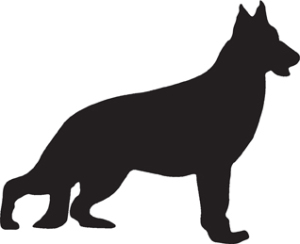The Importance of Follow-through
Teaching your dog new tricks, so to speak, can have its ups and downs. Usually things go well – we practice the exercises and are pleased with the results. But sometimes it’s not all smooth sailing.
Sometimes our dogs get confused. Sometimes our dogs don’t respond as expected. Sometimes our dogs temporarily shut down. We need to take a closer look as to why. There can be many reasons, but sometimes the problem is that we did not follow through with the lessons/training, and that is what I want to address at this time.
Close your eyes for a moment and imagine what it is like to be a dog. A human (familiar or new) starts to engage you to participate in something unfamiliar. The human is trying desperately (and sometimes impatiently) to get you to do something, but you don’t know what. You are confused. The human keeps at it, but is starting to get a little frustrated. There’s a little more tension pulling on your leash, and this is making you feel uncomfortable. If you only understood what they wanted you could try to make the human happy. Suddenly, the human changes what they were doing and starts doing something else. It’s clear he still wants something of you, but what? In frustration, the human walks away. How does that leave you feeling???
Let’s use a common example. Some dog owners decide to install some version of an electric fence in their yard, thinking that their dog will enjoy the “freedom” of the great outdoors. Many dogs do well, as long as the training is clear and thorough. But what about the dog who has gotten a shock or two without redirection and is now confused and scared to go outside? They quiver and shake and put the brakes on when being brought to the door. The poor dog is thinking that bad things happen outside. If more training or follow-through doesn’t occur, the dog may never get over it, and forever be afraid of his own yard. How awful! But that was not the intention. The owner of that dog needs to work hard and patiently so the dog understands that crossing a certain area is what causes the unpleasant correction, not just being outside. And further direction needs to be shown as to what the dog should do next.
Another example is when someone is trying to teach their dog the “Leave It” command. They might set the dog up to be tempted to take something that is not harmful to them (let’s say a piece of food). When the dog goes for the food they say “leave it” and give a correction. If the dog is seriously responsive to the correction they may start to avoid the setup, by walking far out of their way as to not go anywhere near it. AVOIDANCE and nervousness was not the original intention. Unfortunately, the training is NOT complete, but many stop here, thinking they have successfully taught the dog. If there is no follow-through the dog learns to be nervous around the food and is not in a good state of mind. The intent was not to make the dog nervous, but to teach the dog that when they hear “Leave It” they are to do just that – leave it alone/don’t take it!
I’m not bringing this up to make you feel guilty (promise!) 🙂 I’m trying to make a point from which you can learn and become an even better trainer than you already are! Dogs are not robots. And they do not intuitively understand what you want. Teaching them something new requires fairness, patience, and perseverance. They are our companions and we are a team.
Continue to train and challenge your dogs with new lessons on a regular basis. And every so often, try to “see” things from their perspectives!
Yours in good training,
Stacie & Ronan






Leave a Reply
Want to join the discussion?Feel free to contribute!